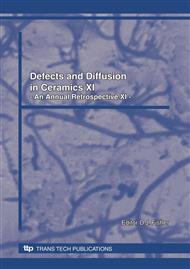p.1
p.11
p.19
p.27
p.33
p.39
p.49
p.69
Effect of Current Density on Composition and Microstructure of Si Diffusion Layer by Electrodeposition
Abstract:
A Si diffusion layer on grain-oriented low-silicon steel substrates was produced by pulse electrodeposition in KCl-NaCl-NaF-SiO2 molten salt and the effect of current density upon the composition and microstructure of the siliconized layer was investigated. The results showed that by glow discharge spectrometry (GDS), the change of Si content of siliconized layers was similar in the range of 20-60 mA/cm2. Si content in the surface was maximum, and then dropped sharply within the surface layer (< 7 m). The Si content remained nearly constant in the middle part of the siliconized layer. The content of Si near to the substrate decreased relatively slowly. The Si content in the surface and the layer thickness increased with increasing current density. Cross-sectional observations revealed that the Si diffusion layers had a two-layer structure: the top layer composed of columnar grains grown perpendicularly to the substrate surface and a transition layer with equiaxed grains was close to the substrate. In addition, the thickness of the layer was too small when the current density was 20 mA/cm2, while the layer became more porous as the current increased from 40 to 60 mA/cm2 according to SEM observations. The optimum current density for deposition was 30 mA/cm2.
Info:
Periodical:
Pages:
33-37
Citation:
Online since:
January 2010
Authors:
Keywords:
Price:
Сopyright:
© 2009 Trans Tech Publications Ltd. All Rights Reserved
Share:
Citation:


